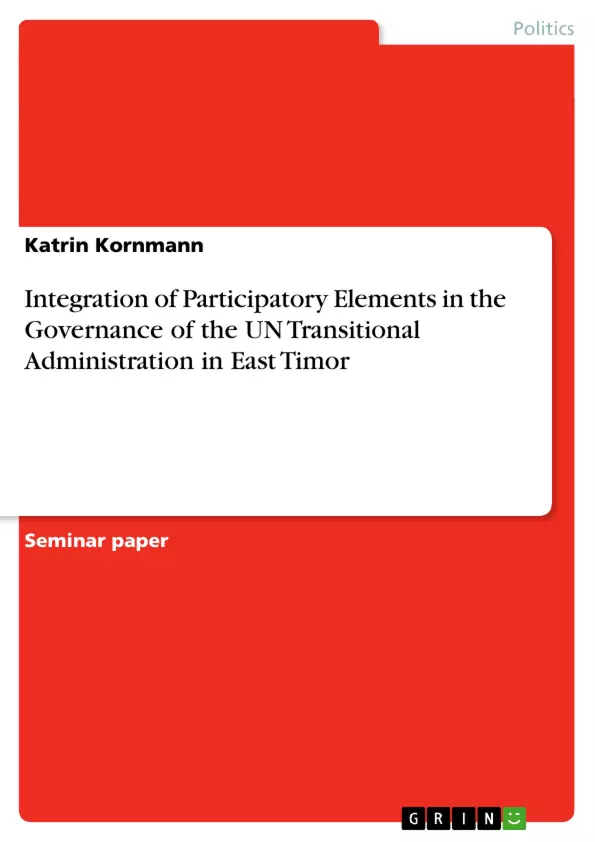The role of the United Nations in the new century will be a different one compared to the traditional observing and discussion role from the past. UN peace-building missions in Kosovo, Eastern Slavonia, East Timor and Cambodia gave a first impression of the future role of the UN in post-conflict situations: To built up a democratic, peaceful nation after war or civil war’s destruction of the country. But how could that impressive task be managed? Which problems could emerge and which processes guarantee a successful mission? Of course there won’t be a ‘one size fits all’ model but the lessons learned of the experiences could help to manage future tasks. In this context, the UN mission in East Timor is said to be very successful because within a few years a multidimensional project built up a working administration and a viable democratic state out of a completely destroyed infrastructure and scorched earth with thousands of dead or fled inhabitants. But what made this mission so successful? Was it the multidimensional mandate? The international experts involved? The preconditions of the conflict? The small size of the country? Or even the ownership of the East Timorese people in the peace-building process? The question of participation is a very important one, especially with the perspective of the people once being independent. During the UN peace-building-process the foundation of the future nation’s governing structure is laid and it is absolutely crucial to involve local actors in the process of state-building. The problem of the performance for the UN exit of the country after the mission is also a problem of lacking former participation. “No exit without a Strategy” Kofi Annan postulated (quoted in Chesterman et al 2004: 15) - the thinking about the Strategy leads to the problem of participation. But how could one prepare a nation for democracy and good governance from the standpoint of a UN transitional government? The governing structure “benevolent despotism” (Chesterman 2002b) through a multidimensional, centralized mandate is not a very good teaching example.
In this work, I would like to focus on one specific theme to analyse - the possibility for the people to participate and the degree of their involvement in the transitional government of the UN. Maybe this task was the key to the overwhelming success of the UN mission in East Timor?
Inhaltsverzeichnis (Table of Contents)
- Introduction
- UNTAET
- Mandate
- Institutional Structure
- Participatory Elements in UNTAET
- Participatory Elements
- Local Governance
- 'Timorization'
- Transfer of Authority
- The Process of Transfer
- Elections
- Conclusion
Zielsetzung und Themenschwerpunkte (Objectives and Key Themes)
This paper examines the degree of East Timorese involvement in the United Nations Transitional Administration in East Timor (UNTAET). It aims to assess the effectiveness of participatory elements in the governance of this transitional administration, specifically the potential for the people to participate and their actual involvement in the process of state-building.
- The role of participation in successful UN peace-building missions.
- The challenges and opportunities of integrating participatory elements in a transitional government.
- The impact of 'benevolent despotism' on the development of local governance and democratic institutions.
- The significance of 'Timorization' in the transfer of authority from UNTAET to an independent East Timor.
- The lessons learned from the UN mission in East Timor for future peace-building efforts.
Zusammenfassung der Kapitel (Chapter Summaries)
- Introduction: This chapter provides an overview of the UN's evolving role in post-conflict situations, focusing on the importance of participation in the peace-building process. It highlights the success of the UN mission in East Timor and raises questions about the factors contributing to its effectiveness, particularly the degree of East Timorese involvement in the transitional government.
- UNTAET: This chapter delves into the mandate, institutional structure, and participatory elements of the UN Transitional Administration in East Timor. It examines the challenges and opportunities of implementing a multidimensional and centralized mandate in a post-conflict environment.
- Participatory Elements: This chapter focuses on the specific ways in which participatory elements were integrated into the governance of UNTAET. It explores the concepts of local governance and 'Timorization' as crucial aspects of transferring authority to the East Timorese people.
- Transfer of Authority: This chapter examines the process of transferring authority from UNTAET to an independent East Timor. It highlights the role of elections and the importance of establishing a stable and democratic governance structure.
Schlüsselwörter (Keywords)
The key terms and concepts in this work include: UN peace-building missions, post-conflict reconstruction, participatory governance, transitional administration, UNTAET, East Timor, local governance, 'Timorization', transfer of authority, elections, and democratic state-building. The analysis focuses on the role of participation, the challenges of 'benevolent despotism,' and the lessons learned from the UN's involvement in East Timor.
- Quote paper
- Katrin Kornmann (Author), 2005, Integration of Participatory Elements in the Governance of the UN Transitional Administration in East Timor, Munich, GRIN Verlag, https://www.grin.com/document/44442



